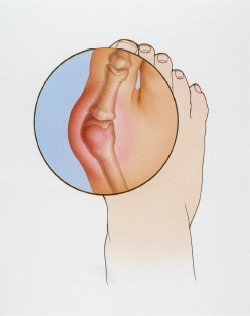Bunions
Bunions (BUN-yunz) are foot deformities caused by displacement of certain bones. A bunion is visible as a bump on the side of the foot at the joint at the base of the big toe.
KEYWORDS
for searching the Internet and other reference sources
Orthopedics
Orthotics
Podiatry
The Price of Style
When Natalie began her job at the bank, she finally could afford to indulge her love of stylish shoes. The higher the heel and the pointier the toe, the better. However, after several months, the inner side of Natalie's right foot, especially around the base of the big toe, began to swell and turn red. As it rubbed against her shoe, the bump on her foot grew bigger. After a few weeks, even sneakers hurt her foot. Natalie knew she had a bunion; bunions ran in her family, and her foot looked just like her mother's and grandmother's feet. She counted the days until her appointment with a podiatrist (po-DY-a-trist), or foot specialist.
What Causes Bunions?
Hallux valgus
The medical term for bunion is "hallux valgus": hallux means big toe, and valgus means a deformity pointing away from the middle of the body. A bunion is formed when the first metatarsal (MET-a-tar-sal), which is the long bone along the inner side of the foot, pushes out at the base of the big toe, and the big toe is displaced toward the smaller toes. The first metatarsal and one of the big toe bones meet at the first joint of the big toe; the bump characteristic of a bunion is caused by inflammation and swelling of this joint.
Anyone can develop a bunion
Bunions are a very common and painful foot deformity. Anyone, including children, can develop a bunion. However, bunions are most common in women over 30, possibly because of shoe choice. Narrow, pointy, high-heeled shoes can speed up the formation of a bunion in people who are susceptible to developing them. People who have flat feet or low arches also are more prone to develop bunions than people with higher arches.
Pronation and other foot abnormalities
Foot abnormalities are a common cause of bunions. For example, people whose feet are rotated so that the inside edge of the foot hits the ground first when they walk (pronated feet) are prone to bunions. Many people have a genetic susceptibility to developing bunions, and bunions also may develop in association with arthritis.

How Are Bunions Treated
Natalie had the classic symptoms of a bunion: the inner side of her foot was deformed by a red, swollen, painful lump the size of a large marble; she also had a big callus (an area of hard thick skin) along the inner side of her foot; her other toes overlapped one another; and sometimes the skin over the bunion became infected.
Before treating the bunion, Natalie's podiatrist took x-rays of her foot to examine the foot bones. She had a large and well-developed bunion, and he decided to inject medication into her big toe joint to reduce the swelling. He also prescribed devices called orthotics * that fit into her shoes to help reduce pressure and weight on her big toe. To help reduce swelling, the podiatrist told Natalie to take aspirin, put ice packs on her foot, and soak her foot in mineral salts. She also would have to give up the high heels.
* orthotic is a support or brace for weak or ineffective joints or muscles.
Osteotomy
These treatments did not work for Natalie, and ultimately she had bunion surgery. The podiatrist performed an osteotomy (os-tee-OT-o-mee), which means "cutting of bone." After giving Natalie local anesthesia to block pain in her foot, the podiatrist removed areas of the metatarsal that had thickened, and he used a small titanium (ty-TANE-ee-um) screw to hold the bones in their correct position. Like almost all bunion repairs, Natalie's was successful. She was walking again the day of the surgery and was back to work in four days.
Resources
Book
Tremaine, M. David, M.D., and Elias M. Awad, Ph.D. The Foot and Ankle Sourcebook: Everything You Need to Know. Lowell House, 1998.
Organizations
American Podiatric Medical Association, 2 Chevy Chase Circle NW,
Washington, DC 20005. The APMA's website features information
about bunions and other disorders affecting the feet.
http://www.apma.org
American College of Foot and Ankle Surgeons, 515 Busse Highway, Park
Ridge, Illinois 60068. This organization's website provides
information about foot health, foot and ankle deformities, and foot
injuries.
http://www.acfas.org
Comment about this article, ask questions, or add new information about this topic: